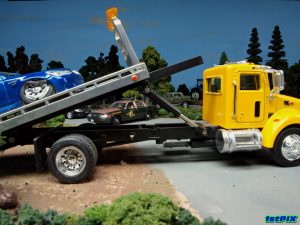Rollback Tow Truck
In many successful towing and hauling operations, the rollback tow truck performs the role of the heart. The rollback tow truck, called a “rollback” for short, makes these operations straightforward. This truck gets its name because most of the back is fitted with a truck bed that can be hydraulically inclined and slid back to ground level utilizing a deck and hydraulic system and a winch and hook to prevent it from rolling around.
As an added convenience, they are equipped with a central control station. We’ll explore the details of the rollback and clarify the critical factors to consider when purchasing any new or used rollback truck.
How do you use a rollback tow truck?
There are many components to how rollback tow trucks are used. A rollback tow truck offers a safe and convenient towing alternative compared to its counterparts, such as wreckers or hook-and-chain trucks. However, how does it work exactly? Featuring features such as control stations and winches and body styles like chassis types and storage options, here are some basics about rollback trucks!
1. The control station
In addition to mobilizing the rollback deck, the control station of a rollback truck performs several functions. A deck jib involves moving the deck away from the cab and toward it, raising and lowering the deck at the desired angle, and releasing or winding the winch to secure vehicles once they are on the deck. Some buttons or levers are dedicated to controlling each of these operations in the side-mounted deck control station.
2. Length of body
Your towing business or fleet will benefit significantly from selecting the appropriate rollback body length. Because of the all-encompassing nature of an operation’s applicable body length, rollback trucks enable your operation to respond to virtually any request or call without question. Since most common rollback truck body lengths measure 19 feet, 20 feet, 21 feet, and 22 feet, the rollback provides plenty of space for most car and truck models while still leaving room for your gear and securement accessories.
3. Using the Winch
Tow trucks deal with two types of vehicles: those that are somewhat mobile and those that are, unfortunately, “please don’t drive me any further.” Winches on rollbacks come in handy when attempting to control the latter’s more “stubborn” nature.
A winch is located on the floor before the headache rack on the front most of the rollback deck, which is housed in a small construction that ensures adequate room for vehicles and equipment. Two levers can pull loads onto the board with the winch powered by winding or releasing the winch.
4. Optional Storage
Even though it is often referred to as a towing master, the rollback tow truck provides additional utility to its users through its integrated toolboxes and storage bins. For the most part, toolboxes are installed under the body, usually on the side. Sturdy steel or aluminum construction and a high level of weather protection are just a few of the features these robust toolboxes offer. Not to mention the secure three-contact locking system and OEM-grade weather sealants.
In most cases, storage bins are placed along the base of the headache rack, along either side of the winch. In addition to housing ratchet-strap assemblies and D-ring nylon straps, these storage bins provide enough room to hold hook-and-loop strap assemblies safely.
What are the advantages of a rollback tow truck?
The towing industry has evolved and changed over time, just like other industries. The traditional method of towing a vehicle used to be to ask someone for help, use a rope and pickup truck, and pull the car on your own. Over time, professional towing trucks became more common. In most cases, there is a hook mounted on the front of the vehicle, allowing the car’s front wheels to be raised off the ground for safe towing. Currently, rollback towing trucks are among the most popular options. The flatbed trailer reduces the risk of damage to your vehicle instead of dragging it behind the car.
Tow trucks can damage the cars they frequently tow, which is one of the primary problems with traditional tow trucks. When swerving to avoid potholes or other obstacles, the tow truck’s hook or chain can damage the frame of the other vehicle.
Rollback tow trucks solve this problem by transporting vehicles on a flat stage rather than towing them behind. The location is angled down to the ground using hydraulics to drive the car. The car is then pulled up onto the stage, and the surface is leveled again. Tow truck drivers can safely haul a loaded vehicle no matter where it needs to go without causing any damage along the way.
In cases where the vehicle’s back wheels have been damaged in an accident, rollback trucks are an excellent choice. Since a car in this condition requires working back wheels to be towable, it cannot be towed by a standard tow truck.
Apart from this, if you are interested to know about Automatic Car Wash then visit our Business category.
How long is a rollback tow truck?
Rollback tow trucks are a common sight on the road, used for transporting vehicles that are either broken down or need to be moved to a different location. When it comes to the length of a rollback tow truck, it can vary depending on the make and model. Typically, a rollback tow truck ranges from 19 feet to 22 feet in length. However, some larger models can be as long as 30 feet.
The length of a rollback tow truck is an important consideration as it determines the vehicle size it can carry. Generally, a rollback tow truck can transport vehicles that weigh up to 10,000 pounds. This includes cars, SUVs, and light-duty trucks. A heavy-duty tow truck may be required if a vehicle is larger than this.
Rollback tow trucks are designed to be versatile and maneuverable, allowing them to navigate through tight spaces and congested roads easily. The length of a rollback tow truck is carefully balanced to provide stability and control while towing vehicles, ensuring the safety of the tow truck driver and other drivers on the road.







